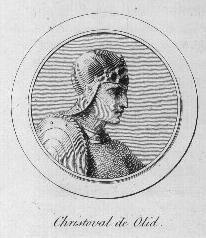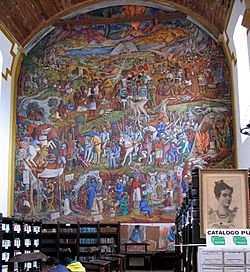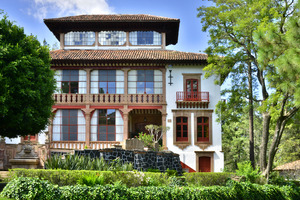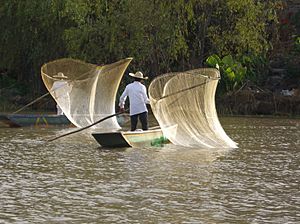Purépecha facts for kids
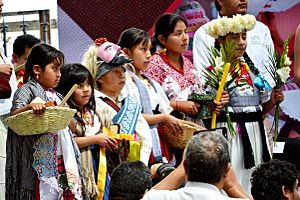
Purépecha children at the 2015 Muestra de Indumentaria Tradicional de Ceremonias y Danzas de Michoacán
|
|
| Total population | |
|---|---|
| 141,177 (2015 census) | |
| Regions with significant populations | |
| Michoacán, México California, Oregon, Washington | |
| Languages | |
| Purépecha | |
| Religion | |
| Roman Catholicism, Purépecha religion |
The Purépecha people are an indigenous group living mainly in the northwestern part of Michoacán, Mexico. This area includes cities like Cherán and Pátzcuaro.
They are also sometimes called "Tarascan," but this is a name given by outsiders. The Purépecha prefer to call themselves P'urhepecha.
Long ago, the Purépecha lived across most of Michoacán. They also lived in parts of Guanajuato and Jalisco. Today, most Purépecha live in the highlands of central Michoacán. This area is around Lake Patzcuaro and Lake Cuitzeo.
Contents
History of the Purépecha People
Ancient Times: Before the Spanish Arrived
The Purépecha created one of the most important empires in the Americas before Europeans arrived. Their main city was Tzintzuntzan. The Purépecha built unique step pyramids that looked like the letter "T".
Purépecha artists were famous for their feather mosaics. They often used shiny hummingbird feathers, which were very valuable.
The Purépecha kingdom often fought with the Aztec Empire. The Purépecha empire grew by conquering other groups. However, some groups avoided war by trading goods like metal with the Purépecha.
The Aztec Empire never managed to conquer the Purépecha. There are no records of the Aztecs ever winning a major battle against them. This was likely because the Purépecha had metal ores and knew how to work with metals. Their metalworking skills were much better than the Aztecs'. These skills are still important to their descendants today, especially their coppersmithing. Even as enemies, the Aztecs traded with the Purépecha for metal tools and weapons.
Spanish Rule (1525-1821)
After hearing about the Spanish conquest of the Aztec Empire, the Purépecha leader, Tangaxuan II, decided to join the King of Spain without a fight in 1525. This happened after many Purépecha people had already died from a smallpox sickness.
A Spanish explorer named Cristóbal de Olid explored parts of Michoacán and Guanajuato in the early 1520s. A famous story tells of a young Purépecha Princess Eréndira. She is said to have led her people in a fierce fight against the Spanish. Her people learned to ride Spanish horses they had captured.
In 1529 and 1530, Spanish forces entered Michoacán and parts of Guanajuato. They had about 500 Spanish soldiers and over 10,000 Native warriors.
However, in 1530, a Spanish leader named Nuño de Guzmán arrived. He was known for being very cruel to Native people. He took many valuable things from the region and had Tangaxuan II killed. This destroyed the Purépecha kingdom and caused a lot of chaos and violence.
In 1533, the Spanish Crown sent a judge and later bishop, Don Vasco de Quiroga. He helped establish a more stable Spanish rule. During this time, many trees were cut down in Purépecha lands.
After Mexico's Independence
The Cárdenas Era
After the Mexican Revolution (1910-1920), Michoacán faced political problems. Lázaro Cárdenas, a former general from Michoacán, became governor. He started big plans for reform and economic growth. He continued these plans when he became president of Mexico (1934–40).
Cárdenas believed that Michoacán's indigenous history was key to Mexico's new identity. While the Aztecs were important, Cárdenas saw the Purépecha as a "purer" source of Mexican heritage. The Purépecha had never been conquered by the Aztecs. Their resistance against the Spanish was a source of great pride for the region.
Cárdenas especially promoted the story of Princess Eréndira. He named his house in Pátzcuaro "La Quinta Eréndira." He also hired artists to paint murals showing Purépecha history in his home and other places. Purépecha traditions, like their dances and performances, became a symbol of indigenous pride.
Purépecha Religion
Many Purépecha traditions continue today. One important celebration is the Jimbani Uexurhina, or New Year, on February 2. This holiday mixes traditional indigenous beliefs with Catholic elements.
During the ceremony, the community lights a fire called the chijpiri jimbani, or "new fire." This honors the four elements. Mass is also celebrated in the Purépecha language.
The ancient Purépecha believed in gods of the sky, earth, and underworld.
- The God of the sky and war was Kurikaweri.
- The Goddess of earth, who controlled life and climate, was Kweawaperi.
- The Goddess of the sea and the underworld was Xaratenga.
Purépecha Culture
The Purépecha are known for their fishing skills. This is because they traditionally lived around the Patzcuaro lakes. They are also famous for their weaving and pottery.
Many Purépecha used to live in wooden cabins surrounded by stone walls. However, many new homes are now made of brick and concrete.
A special Purépecha custom is the baptism of newborns. After a mother and baby rest for forty days, the baby is baptized. Then, the infant is wrapped tightly for six weeks. The baby is kept close to the mother or another female relative.
Purépecha temples looked different from other temples in Mesoamerica.
Today, the Purépecha celebrate many holidays. One of the most popular is the "Día De Los Muertos". While celebrated across Mexico, the Purépecha have their own unique way. On November 1st and 2nd, families spend the whole night at the graves of their loved ones. Purépecha people believe that the souls of the dead watch over their living relatives on this day.
In the Purépecha town of San Juan Nuevo Parangaricutiro, unmarried men perform the Dance of the Cúrpites. This dance shows their strength and helps them try to win the heart of a sweetheart. This dance is celebrated during the Christian holiday of Epiphany.
Purépecha Language

The Purépecha language is spoken by almost 200,000 people in Michoacán. Since Mexico passed an indigenous language law in 2000, languages like Purépecha have the same official status as Spanish in the areas where they are spoken.
Recently, schools in Purépecha communities have started teaching in the Purépecha language. Many communities also offer classes and lessons to help people learn the language.
Purépecha in Popular Culture
Princess Eréndira of the Purépecha was shown in the 2006 movie Erendira Ikikunari. The movie's title means Erendira the Untameable.
See also
 In Spanish: Pueblo purépecha para niños
In Spanish: Pueblo purépecha para niños


